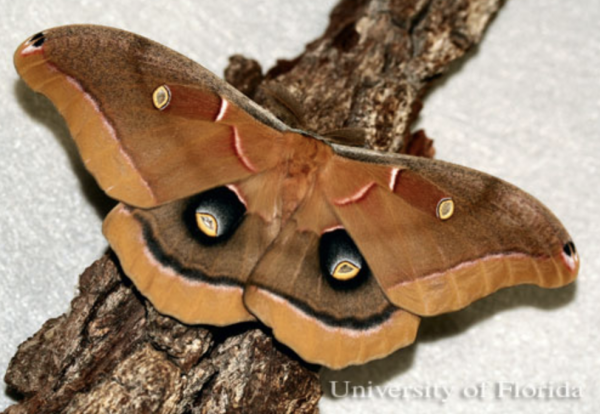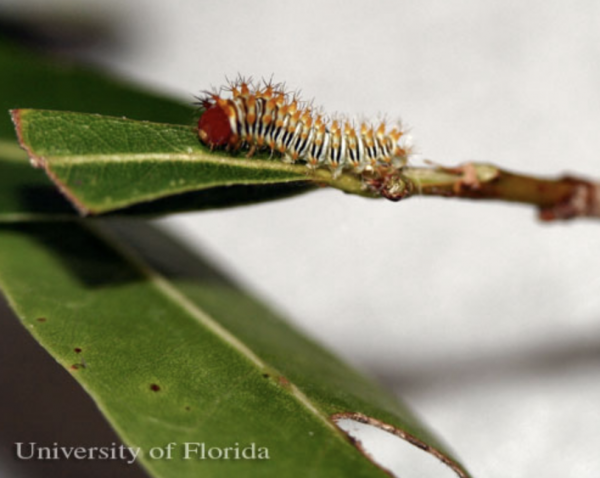Moths have been around for far too long. In fact, they are much older than butterflies and bees. The oldest moth fossil reveals that these fliers probably date back to 190 million years. Moths, butterflies and skippers make up the order Lepidoptera. There are 160,000 species of moths in this order. According to one estimate, there are about 200,000 species of butterflies and moths that are still undiscovered. Moths outnumber their less hairy cousins (i.e. butterflies) as well as skippers by 15 to 1. As far as number of species are concerned, these less flashy relatives are second only to beetles.
The United States is home to more than 12,000 moth species that are classified into 65 families. Likewise, there are more than 2,500 species of moths in the UK alone. Skippers are somewhat similar to moths but they are considered a different kind of species. With 3,500 species of skippers, these insects fall between moths and butterflies.

Adult male Polyphemus Moth (Antheraea polyphemus). Photo © Donald W. Hall. Image Source: Entomology & Nematology, University of Florida
There is a huge diversity in the size, shape and color of moths. Besides, they also offer a lot of ecological benefits. No wonder, they are one of the great pollinators thanks to their hairy bodies that pick up pollen from a variety of flowers. Sphinx moths, for instance, pollinate papaya trees and a lot of other orchids.
Moths have evolved to mimic other insects like praying mantis, wasps, tarantulas and even bird droppings. They do this to fend off predators so that they may look like an insipid meal to them. They usually hold their wings horizontally and cover their abdomens in a tent-like fashion. Thus, they are pretty nice ‘hiders’. However, butterflies are quite different since they hold their wings vertically up. What make these creatures furry is the tiny scales that cover their entire bodies and wings. These scales are actually modified hairs.
In summertime, we can’t help but observe moths gathering around lamps. Actually, their tiny eyes are tuned to faint light. But when they see pretty powerful artificial lamps, it confuses their own navigational systems. As a result, they are drawn to such bright lights because these act as ‘super-stimulant’, according to Lynn Kimsey, entomology professor at the University of California, Davis.
Now let’s deep dive into what do moths eat in nature!
What Do Moths Eat in the Wild
There are some moths that devour a wide range of crops like African armyworm moth. While most of them lap up nectar, there are others that lack mouthpart and don’t eat at all. They sniff around by means of their threadlike antennae that contain scent receptors.
Hummingbird moths lap up nectar from a wide variety of flowers such as verbena, bee balm, and honeysuckle.
With a wingspan of 24 cm, Atlas moth is by far one of the largest insects of Lepidoptera. The caterpillars of these moths start eating voraciously on tree species like guava, citrus, evergreen, and cinnamon. Because they have such a short proboscis, the adult atlas moths are unable to eat. For that reason, they have to rely only on their fat reserves that they build up when they were caterpillars.

First instar larva of Polyphemus Moth. Photo © Donald W. Hall. Image Source: Entomology & Nematology, University of Florida
The caterpillars of the white witch moth probably feed on the woody flowering plants of the bean family.
With a wingspan of 27 cm, the Hercules moth is the largest Australian moth. The larvae of this species of moth chew mainly on the leaves of celery wood (rainforest tree), cheese tree, and wild black cherry (a deciduous tree).
The Madagascan sunset moth is one of the most attractive-looking insects. Unlike many other moth species, the sunset moth is active during the day. During larval stage, these insects feed on young stems, tendrils, petioles, flowers, and fruits. The adults usually acquire nectar from (white or yellow) small clustered flowers including country almond, tea shrub, loquat, Sydney blue gum tree, Cussonia, and mango tree leaves.
There are three species of moths within the genus Acherontia. All of these large moths are known as death’s-head hawkmoth, since there is a pattern of human skull at the center of their bodies (called thorax). It is quite a powerful insect and also the largest in the British Isles. The adults are known to swoop down on the beehives of various species of honey bee. Interestingly, since these moths can mimic the scent of a honey bee, the bees can’t recognize them as invaders. As a result, they can invade colonies and move about in beehives rather easily. What’s more, when threatened, they can emit a loud chirp and their abdomen also begin flashing. The larvae of these moths feed on the leaves of potato, bitter nightshade, tomato, jasmine, and European buckthorn. Actually, there are toxic akaloids within the leaves of potato plant and these caterpillars sip these organic compounds.
Like grain moths, the caterpillars of grease moths also eat corn meal, graham flour, wholemeal flour, granola, and other dried oats. However, the adult moths ingest suet, grease, and butter. Moreover, they also eat dried remains of insects.
The larvae of polyphemus moth feed on the leaves of oak, maple, birch, honey locust, American elm, hickory, willow, walnut trees, and shrubs and trees of citrus fruits, peach, apricots, and plums.
The winter moths are native to Europe. During larval stage, they mainly favor oak, maple and apple tree leaves. In addition to these, they eat other leafy trees such as chestnut, poplar, beech, quince, birch, hazel, larch, blueberries and raspberries, willow, crabapple, basswood, pears and cherries. They do not seem to feed on broad-leaved evergreens.
Luna moth is arguably one of the most beautiful moths. The caterpillars of luna moth feed on the leaves of various broadleaf trees including paper birch, walnut, common persimmon, hickory, sumac, and American storax.
Cotton bollworm moth is a major agricultural pest since it eats a huge range of crops including French beans, garden asparagus, cantaloupe, cabbage and lettuce, eggplant, butter bean, tomato, sweet potato, pea, collards, melon, ladies’ fingers, spinach, French artichoke, and pumpkin.
Clothes moths are well-known pests that feed only on felt, fur, feathers, leather, silk, and other animal fibers.
Sources & References:
W. Hall, Donald. “Luna Moth”. Entomology and Nematology Department, University of Florida.
Robinson, G.S., Ackery, P.R., Kitching, I.J., Beccaloni, G.W. & Hernández, L.M. (2001). Hostplants of the Moth and Butterfly Caterpillars of the Oriental Region. Southdene Sdn. Bhd., Kuala Lumpur & The Natural History Museum, London. 744 pp.
Robinson, Gaden S.; Ackery, Phillip R.; Kitching, Ian J.; Beccaloni, George W.; Hernández, Luis M. (2010). “Search the database – introduction and help”. HOSTS – A Database of the World’s Lepidopteran Hostplants.
Lees, David; Smith, Neal (1991). “Foodplants of the Uraniinae (Uraniidae) and their Systematic, Evolutionary and Ecological Significance” (PDF). Journal of the Lepidopterists’ Society. The Lepidopterists’ Society. 45 (4): 296–347.
O’Donnell, Kaitlyn M., “The Relationship Between the Winter Moth (Operophtera brumata) and Its Host Plants in Coastal Maine” (2015). Electronic Theses and Dissertations. 2338
“The Lord’s Committee on Rabies”. The British Medical Journal. 20 August 1887. PubMed Central. p 424. U.S. National Institutes of Health. 18 March 2009.
Moritz, R.F.A.; Kirchner, W.H.; Crewe, R.M. 1991. Chemical camouflage of the death’s head hawkmoth (Acherontia atropos L.) in honeybee colonies. Naturwissenschaften 78 (4): 179-182.
Nash, Robert J.; Rothschild, Miriam; Porter, Elaine A.; Watson, Alison A.; Waigh, Roger D.; Waterman, Peter G. (1993). “Calystegines in Solanum and Datura species and the death’s-head hawk-moth (Acherontia atropus)”. Phytochemistry. 34 (5): 1281–1283.
Lees, David; Smith, Neal (1991). “Foodplants of the Uraniinae (Uraniidae) and their Systematic, Evolutionary and Ecological Significance” (PDF). Journal of the Lepidopterists’ Society. The Lepidopterists’ Society. 45 (4): 296–347
Tuskes PM, Tuttle JP, Collins MM (1996), The Wild Silk Moths of North America: A Natural History of the Saturniidae of the United States and Canada, Ithaca, New York: Cornell University Press, pp. 182–184
Harding JA (August 1976). “Heliothis spp.: seasonal occurrence, hosts and host importance in the lower Rio Grande Valley”. Environmental Entomology. 5 (4): 666–8
Y. Kawahara, Akito, et. al. “Phylogenomics reveals the evolutionary timing and pattern of butterflies and moths“. PNAS. First published October 21, 2019.
Hertzberg, Richie. “Why insects like moths are so attracted to bright lights“. National Geographic.
Johnstone, Caitlyn. “Moths pick up the night shift“. Chesapeake Bay Program.
A. Raguso, Robert and Mark A. Willis. “Moths“. Arizona-Sonora Desert Museum.
“Everyday Mysteries: How can you tell the difference between a butterfly and a moth?“. Library of Congress
F. Potter, Michael. “Clothes Moths“. College of Agriculture, Food and Environment, Entomology at the University of Kentucky.
Britannica, The Editors of Encyclopaedia. “Moth“. Encyclopedia Britannica, 28 Feb. 2021.
Konkel, Lindsey. “7 Things you don’t know about moths, but should“. LiveScience.
“Moths“. National Museum of Natural History, Entomology Section of Smithsonian Institution.
“Winter Moth Identification and Management“. Center for Agriculture, Food and the Environment, University of Massachusetts Amherst.
